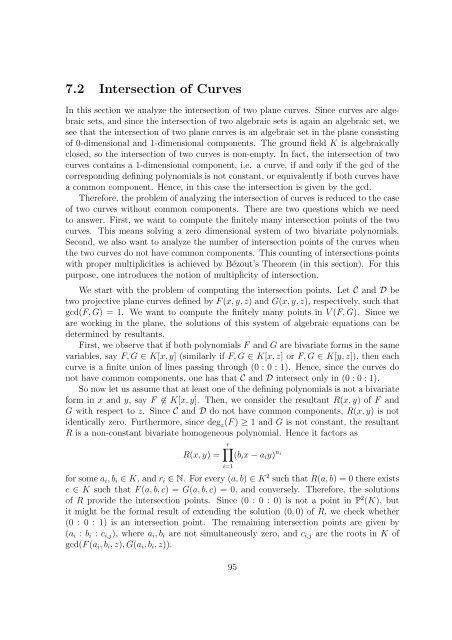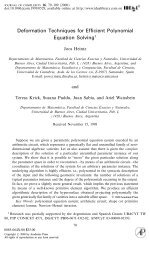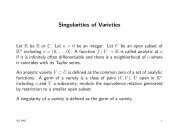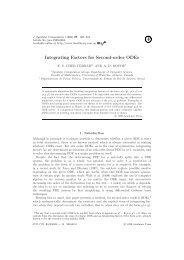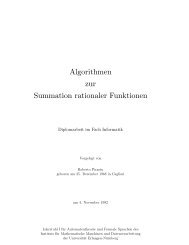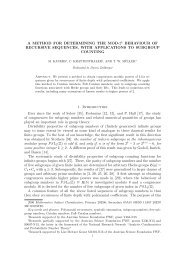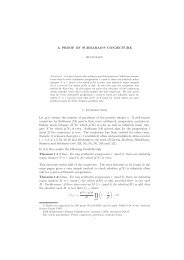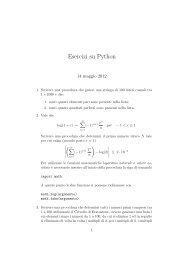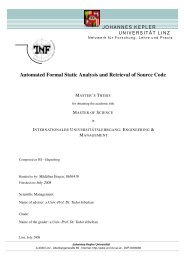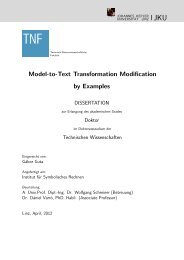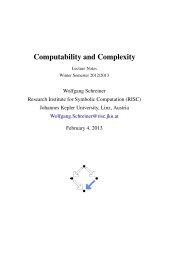Chapter 7 Local properties of plane algebraic curves - RISC
Chapter 7 Local properties of plane algebraic curves - RISC
Chapter 7 Local properties of plane algebraic curves - RISC
You also want an ePaper? Increase the reach of your titles
YUMPU automatically turns print PDFs into web optimized ePapers that Google loves.
7.2 Intersection <strong>of</strong> Curves<br />
In this section we analyze the intersection <strong>of</strong> two <strong>plane</strong> <strong>curves</strong>. Since <strong>curves</strong> are <strong>algebraic</strong><br />
sets, and since the intersection <strong>of</strong> two <strong>algebraic</strong> sets is again an <strong>algebraic</strong> set, we<br />
see that the intersection <strong>of</strong> two <strong>plane</strong> <strong>curves</strong> is an <strong>algebraic</strong> set in the <strong>plane</strong> consisting<br />
<strong>of</strong> 0-dimensional and 1-dimensional components. The ground field K is <strong>algebraic</strong>ally<br />
closed, so the intersection <strong>of</strong> two <strong>curves</strong> is non-empty. In fact, the intersection <strong>of</strong> two<br />
<strong>curves</strong> contains a 1-dimensional component, i.e. a curve, if and only if the gcd <strong>of</strong> the<br />
corresponding defining polynomials is not constant, or equivalently if both <strong>curves</strong> have<br />
a common component. Hence, in this case the intersection is given by the gcd.<br />
Therefore, the problem <strong>of</strong> analyzing the intersection <strong>of</strong> <strong>curves</strong> is reduced to the case<br />
<strong>of</strong> two <strong>curves</strong> without common components. There are two questions which we need<br />
to answer. First, we want to compute the finitely many intersection points <strong>of</strong> the two<br />
<strong>curves</strong>. This means solving a zero dimensional system <strong>of</strong> two bivariate polynomials.<br />
Second, we also want to analyze the number <strong>of</strong> intersection points <strong>of</strong> the <strong>curves</strong> when<br />
the two <strong>curves</strong> do not have common components. This counting <strong>of</strong> intersections points<br />
with proper multiplicities is achieved by Bézout’s Theorem (in this section). For this<br />
purpose, one introduces the notion <strong>of</strong> multiplicity <strong>of</strong> intersection.<br />
We start with the problem <strong>of</strong> computing the intersection points. Let C and D be<br />
two projective <strong>plane</strong> <strong>curves</strong> defined by F(x, y, z) and G(x, y, z), respectively, such that<br />
gcd(F, G) = 1. We want to compute the finitely many points in V (F, G). Since we<br />
are working in the <strong>plane</strong>, the solutions <strong>of</strong> this system <strong>of</strong> <strong>algebraic</strong> equations can be<br />
determined by resultants.<br />
First, we observe that if both polynomials F and G are bivariate forms in the same<br />
variables, say F, G ∈ K[x, y] (similarly if F, G ∈ K[x, z] or F, G ∈ K[y, z]), then each<br />
curve is a finite union <strong>of</strong> lines passing through (0 : 0 : 1). Hence, since the <strong>curves</strong> do<br />
not have common components, one has that C and D intersect only in (0 : 0 : 1).<br />
So now let us assume that at least one <strong>of</strong> the defining polynomials is not a bivariate<br />
form in x and y, say F ∉ K[x, y]. Then, we consider the resultant R(x, y) <strong>of</strong> F and<br />
G with respect to z. Since C and D do not have common components, R(x, y) is not<br />
identically zero. Furthermore, since deg z (F) ≥ 1 and G is not constant, the resultant<br />
R is a non-constant bivariate homogeneous polynomial. Hence it factors as<br />
r∏<br />
R(x, y) = (b i x − a i y) n i<br />
i=1<br />
for some a i , b i ∈ K, and r i ∈ N. For every (a, b) ∈ K 2 such that R(a, b) = 0 there exists<br />
c ∈ K such that F(a, b, c) = G(a, b, c) = 0, and conversely. Therefore, the solutions<br />
<strong>of</strong> R provide the intersection points. Since (0 : 0 : 0) is not a point in P 2 (K), but<br />
it might be the formal result <strong>of</strong> extending the solution (0, 0) <strong>of</strong> R, we check whether<br />
(0 : 0 : 1) is an intersection point. The remaining intersection points are given by<br />
(a i : b i : c i,j ), where a i , b i are not simultaneously zero, and c i,j are the roots in K <strong>of</strong><br />
gcd(F(a i , b i , z), G(a i , b i , z)).<br />
95


